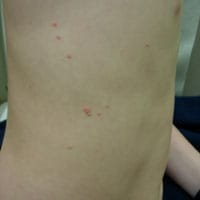Clinical Information
Etiology
Molluscum contagiosum is a benign superficial skin disease caused by a poxvirus. It is characterized by small pearly papules with a central depression whose core may be expressed, producing a white cheesy material. The lesions average 2 to 5 mm in size and are usually painless, but may become inflamed, red, and swollen. Molluscum contagiosum is a self-limited infection; the papules usually disappear spontaneously within 6 to 12 months but may take as long as 4 years to resolve.
Clinical Features
The infection is found worldwide but is more common in developing countries and has traditionally been regarded as a pediatric disease. Successful vaccination against smallpox in infancy is not protective. Little has been verified with regard to the incubation period; however, it is estimated to be between 2 weeks and 6 months. Most cases occur in children over 1 year of age, with only one known case reported in an infant (at 7 days post-partum). Atopic dermatitis may be a risk factor for contracting molluscum contagiosum due to the barrier breaks and immune cell dysfunction in atopic skin. In addition, these patients may be more likely to autoinoculate (excoriation of primary lesions and spread to areas of normal skin) new areas of skin because of the underlying pruritus from their atopy.
Patients with HIV/AIDS and other immunocompromising conditions (e.g., solid organ transplant recipients) can develop “giant” lesions (≥15 mm in diameter), larger numbers of lesions, and lesions that are more resistant to standard therapy. The following diseases should be considered in the differential diagnosis of molluscum contagiosum: cryptococcosis, basal cell carcinoma, keratoacanthoma, histoplasmosis, coccidioidomycosis, and verruca vulgaris. For genital lesions, condyloma acuminata and vaginal syringomas should be considered.
Molluscum contagiosum lesions have recently come to be classified in one of three ways: the commonly seen skin lesions found largely on the faces, trunks, and limbs of children; the sexually transmitted lesions found on the abdomen, inner thighs, and genitals of sexually active adults; and the diffuse and recalcitrant eruptions of patients with AIDS or other immunosuppressive disorders.

Typical molluscum lesions on the torso of a child. Typical lesions are approximately 3-5 mm in diameter. Image courtesy Dave Bray, MD, Walter Reed Army Medical Center.